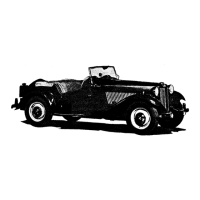o
THE
\VIlEEL~
AND
TYRES~~~~~~~~~--~-
Should'
applied
Reverse this
procedure
when
replacing
the
road
wheel and
ensure
that
the
wheel stud
nuts
are
tight.
This is
important.
To refit
the
hub disc,
the
rim should be placed
over
two
of
the
buttons
on
the
wheel
centre
and
the
outer
face given a sharp blow of
the
fist
over
the
thl rd
button.
~\
r"':'·
.,,'
Fig.
0.3.
The
wheel
hub disc is removed by usIng
the
f1
..
ttened
end
of
the
wheel
nut
brace and giving it a sideways motion.
The
volves
Valve
caps, in addition
to
preventing
dirt
from
entering
the
valve, form a secondary air seal and should
always be fitted. The valves may be
tested
for air-
tIghtness by
rotating
the
wheel until
the
valve Is at
the
top
and Inserting Its end in an eggcup full of
water.
If bubbles
appear
the
seating is faulty and should be
removed and replaced by a new
one.
It Is advisable
to
change
the
valve
Interiors
every
twelve
months.
Tyre
wear
Even
tyre
wear
Is
promoted
by changing
the
posi-
tions of
the
tyres
on
the
car
at intervals of about
2,000 miles (3200 km.).
Attention
should be paid
to
the
following points,
with
a view
'to
obtaining
the
maximum mileage from
the
tyre
eq ui
pment
of th e veh lcle
:-
Test
pressures of
the
tyres
daily by means of a
suitable gauge, and
restore
any
air
lost. It is
not sufficient
to
make a visual examination of
the
tyre
for
correct
Inflation. Inflate
the
spare
wheel
to
the
correct
rear
wheel
pressure
at
the
same
time.
0.2
Should any
tyre
appear
to
lose an appreciable'
amount
of air
between
short
intervals.
have-
it removed and checked for air leaks.
Regularly remove and examine
both
covers and
tubes. Keep
the
tread
free from
grit
and
stones, and
arrange
for any repairs
to
be Carried
out.
Clean
the
wheel rims and keep
them
free
from rust.
Paint
the
wheels jf
required.
and replace
the
tyres
and
tubes.
Keep
the
brakes and clutch
adjusted
correctly
and in good
order.
Fierce-
ness
or
uneven action In
either
of
these
units,
has a
destructive
effect on
the
tyres.
Misalignment is a very costly
error.
Suspect
it if rapid
wear
of
the
front
tyres is noticed. and
correct
the
fault at once. See Section
K.'
for
details of
front
wheel alignment.
I. IJ'laer-t
rever
betwr:en
bead
and
rim.
with
curved
end
aCain5t
tyre.
Press lever
(OWl
rdt
r:yr
e,
2. In
HI
rt
u:co
nd leve r in .space
between
boad and ri m t wi t n cu
rved
and
o1.nwards. and pull
lever
-awayfrom
tyre.
R.epeat at intety;als.
round
tyre
until
bead
[I (f'ee.
:5~veral
circuits
of
tyr-e may be
necessary.
Fig. OA.
The Dunlop tyres fitted as standard
to
the
M.G.
"TD"
have wired edges and no
attempt
must be made
to
stretch
them. If
the
cover
edge fits tlghtl¥ on
the
rim seating it:
should be freed by using
the
tyre
levers as indicated.
Keep oil and grease off
the
tyres,
the
tyres
get
oily, petrol should be
sparingly and wiped off at once.
Note.-Inextensible wires are incorporated
In
the-
edges of wired-type tyres.
Do
not, therefore, attempt
to-
stretch the
edges
of
the tyre
cover
over the rim edge.
Force is
entirely
unnecessary and
detrimental,
as It
tends
to
damage
the
wire
edges and serves no useful,
purpose. Fitti ng
or
re moving is
quite
easy if th e wire
edges
are
carefully adjusted
into
the
rim
base;
if it
is found
to
be difficult
the
operation
is
not
being
performed
correctly
(see Fig.
0.4).
M.G. Midget. Issue 3 (H & E) 91826-2.-55;
Wishvilles Classic
Automobile Library

